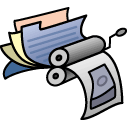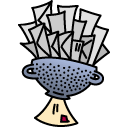Archive for April 2005
Friday, April 29, 2005
 DropDMG 2.6 adds support for Tiger and Automator. I think Brent Simmons is right that Automator will be the “sleeper hit” of Tiger. DropDMG is an application that really lends itself to automation, but most people don’t want to script or use the command-line tool, even though with DropDMG they’d usually only be writing a one-line script. At various points over the past few years, I was considering adding a feature to save the current preferences as an AppleScript or droplet. But I was never really happy with these ideas, because to do interesting things—combine image/archive creation with other tasks—you still had to know how to script. Automator goes much further. It lets you combine DropDMG with actions from other applications, and my sense is that for straightforward kinds of automation it’ll be easier and faster than AppleScript, even for people who know AppleScript. Once you’ve created an Automator workflow, you can save it as a droplet, contextual menu item, folder action, etc.
DropDMG 2.6 adds support for Tiger and Automator. I think Brent Simmons is right that Automator will be the “sleeper hit” of Tiger. DropDMG is an application that really lends itself to automation, but most people don’t want to script or use the command-line tool, even though with DropDMG they’d usually only be writing a one-line script. At various points over the past few years, I was considering adding a feature to save the current preferences as an AppleScript or droplet. But I was never really happy with these ideas, because to do interesting things—combine image/archive creation with other tasks—you still had to know how to script. Automator goes much further. It lets you combine DropDMG with actions from other applications, and my sense is that for straightforward kinds of automation it’ll be easier and faster than AppleScript, even for people who know AppleScript. Once you’ve created an Automator workflow, you can save it as a droplet, contextual menu item, folder action, etc.
One of the less interesting, but still important, new features in Tiger is that many of the Unix tools now support resource forks and Mac metadata. One such tool is tar, and so DropDMG now supports creation of .tar.gz and .tar.bz2 archives. (Previous versions could convert these formats but not create them.)
2.6 also add support for some old formats—uncompressed read-only and read-write NDIF .img images. This is by popular request. Apparently some people use them with emulators and for exchanging files with OS 9 users.
Lastly, as far as the non-minor changes go, 2.6 adds two “name processing” options. You can have DropDMG automatically add the current date to the end of the image or archive name, and you can have it “sanitize” the name so that when you upload the file to a server it’s guaranteed to have a clean URL.
DropDMG
Thursday, April 28, 2005
John Siracusa’s Tiger review is one of the best Mac articles I’ve ever read.
In the previous post, I mentioned BBEdit’s disk browsers. These are one of my favorite features, but many BBEdit users don’t seem to use them. This is how I use them. Much of what I do revolves around three basic activities:
-
Finding a file to work on.
-
Viewing or editing the file, usually in BBEdit, Interface Builder, Safari, or Photoshop.
-
Running shell commands on the file or its relatives.
It’s essential that I be able to move from one activity to another quickly. Disk browsers combined with some AppleScripts make it convenient for me to use BBEdit as the hub. I can almost everything without using Xcode or the Finder.
To view files, or pick one to work on, I use disk browsers. They’re much faster than the Finder (or Path Finder, which I use when I need to move or copy files) to move up and down levels and peek at the contents of files or folders.
To edit a file in a disk browser, I select it (usually by typing the first few letters of its name) and press Return. This opens it for editing in BBEdit. Pressing Option-Return opens it in the default application, instead of BBEdit. Thus, if I have an HTML file I can press Return to edit it, or Option-Return to preview it in Safari. Or, if I have a package, I can press Return to treat it as a folder and view its contents in the disk browser, or Option-Return to open it as a package.
When I’m editing a file, I might want to view its parent folder or one of its siblings. Running this script opens a new disk browser window that makes it easy to do this.
Or, I may want to run shell commands on the file that I’m editing or on one of its relatives that I’m viewing in a disk browser. To do that, I run a script to open a shell worksheet or Terminal window with the proper working directory.
When I’m in a shell, I can use the bbedit tool to get back to an editing window (if I give it a file) or disk browser (if I give it a folder).
BBEdit 8.2 adds lots of Automator actions. It looks like you can do everything with Automator that you could do with Text Factories. There doesn’t seem to be any interoperability between Automator and Text Factories, however.
My favorite new feature is the pop-up menu of recent folders (or locked folder aliases) in Disk Browser windows. It sounds minor, but it will really affect the way I work. Also, I may be using the new Go To Next/Previous Function commands. I used to use those a lot in Emacs, because it doesn’t have a function pop-up. BBEdit does, but I imagine that it will be nice to jump around using the keyboard sometimes.
Aliases BBEdit
Wednesday, April 27, 2005
Peter Seibel’s recently released Practical Common Lisp book is now available online (via Keith Devens).
John Gruber:
Why not use InDesign? Why not allow a skilled page designer to typeset it? Adobe is arguably the world’s best typography company; both in terms of technology and the quality and quantity of faces in their type library. But if you didn’t know this, you’d never guess it by looking at the company’s crudely-typeset marketing material.
Monday, April 25, 2005
 SpamSieve 2.3 adds accuracy improvements, better auto-training (especially for new installations), Tiger support, improved scriptability, and more.
SpamSieve 2.3 adds accuracy improvements, better auto-training (especially for new installations), Tiger support, improved scriptability, and more.
SpamSieve
Tim O’Reilly:
Based on data from Neilsen Bookscan, which aggregates point-of-sale data from about 70% of US bookstores, including Amazon, Barnes & Noble, Borders, and many smaller chains and leading independent bookstores, computer book sales, which have been falling by about 20% a year since 2001, have stabilized, and started to climb again. O’Reilly’s internal market research group has built a MySQL data mart containing the Bookscan data since early 2003, and uses it for visualization and trend analysis.
Monday, April 18, 2005
Buzz Andersen:
I think there’s a feeling, perhaps, that in publishing their white paper and coining their own name, the hipster consultants at Adaptive Path are laying claim to, or at least hitching themselves to, someone else’s revolution.…Haughey is right, though: we need a succinct way of referring to this architectural style, and Ajax is as good as any.
Wednesday, April 13, 2005
Print Free Graph Paper has PDFs with various sizes and styles of grids so that you can print your own graph paper (via Bradley Rhodes).
Monday, April 11, 2005
Matthew P. Thomas:
Sponsored by Canonical, Ubuntu is the latest and greatest operating system built on the Linux kernel, Gnome, the GNU utilities, and the Debian packaging system. Ubuntu 5.04, otherwise known as “Hoary Hedgehog”, was released a little over 48 hours ago. It is the first Linux-based system I have encountered that is tolerable enough for me to use for everyday work. That is a great achievement. But Ubuntu is still rife with design flaws, some of them severe.
Sunday, April 10, 2005
Brent Simmons:
Me, I usually have a few applications open at a time, like most people, and I tend to leave them running. I’ve noticed that different people do different things when switching applications. Some people close their windows, other people minimize, and other people hide applications.
I like the idea of Exposé, but since hidden windows don’t show up in it, I don’t find myself using it very much.
Thursday, April 7, 2005
Some basic command line tips:
pushd/popd: snapback for directories
Great explanation.
Don’t Fear the Assembler:
Hey, I learned [assembly] once when I was a kid, I could do it again. It can’t, after all, be as difficult as AppleScript.
That’s not fair, but it’s not wrong, either.
Arve Bersvendsen (via Ian Betteridge):
Some time ago, I came across a website plagiarism search engine named Copyscape and, just for fun I thought I’d run some of my pages through it. One of the pages I searched for copies of, was my Rounded corners in CSS tutorial.
Much to my surprise, I did find a copy. Not from some owner of a small personal website, but from Apple Computer, Inc.
Friday, April 1, 2005
The April issue of ATPM is out:
![]() DropDMG 2.6 adds support for Tiger and Automator. I think Brent Simmons is right that Automator will be the “sleeper hit” of Tiger. DropDMG is an application that really lends itself to automation, but most people don’t want to script or use the command-line tool, even though with DropDMG they’d usually only be writing a one-line script. At various points over the past few years, I was considering adding a feature to save the current preferences as an AppleScript or droplet. But I was never really happy with these ideas, because to do interesting things—combine image/archive creation with other tasks—you still had to know how to script. Automator goes much further. It lets you combine DropDMG with actions from other applications, and my sense is that for straightforward kinds of automation it’ll be easier and faster than AppleScript, even for people who know AppleScript. Once you’ve created an Automator workflow, you can save it as a droplet, contextual menu item, folder action, etc.
DropDMG 2.6 adds support for Tiger and Automator. I think Brent Simmons is right that Automator will be the “sleeper hit” of Tiger. DropDMG is an application that really lends itself to automation, but most people don’t want to script or use the command-line tool, even though with DropDMG they’d usually only be writing a one-line script. At various points over the past few years, I was considering adding a feature to save the current preferences as an AppleScript or droplet. But I was never really happy with these ideas, because to do interesting things—combine image/archive creation with other tasks—you still had to know how to script. Automator goes much further. It lets you combine DropDMG with actions from other applications, and my sense is that for straightforward kinds of automation it’ll be easier and faster than AppleScript, even for people who know AppleScript. Once you’ve created an Automator workflow, you can save it as a droplet, contextual menu item, folder action, etc.